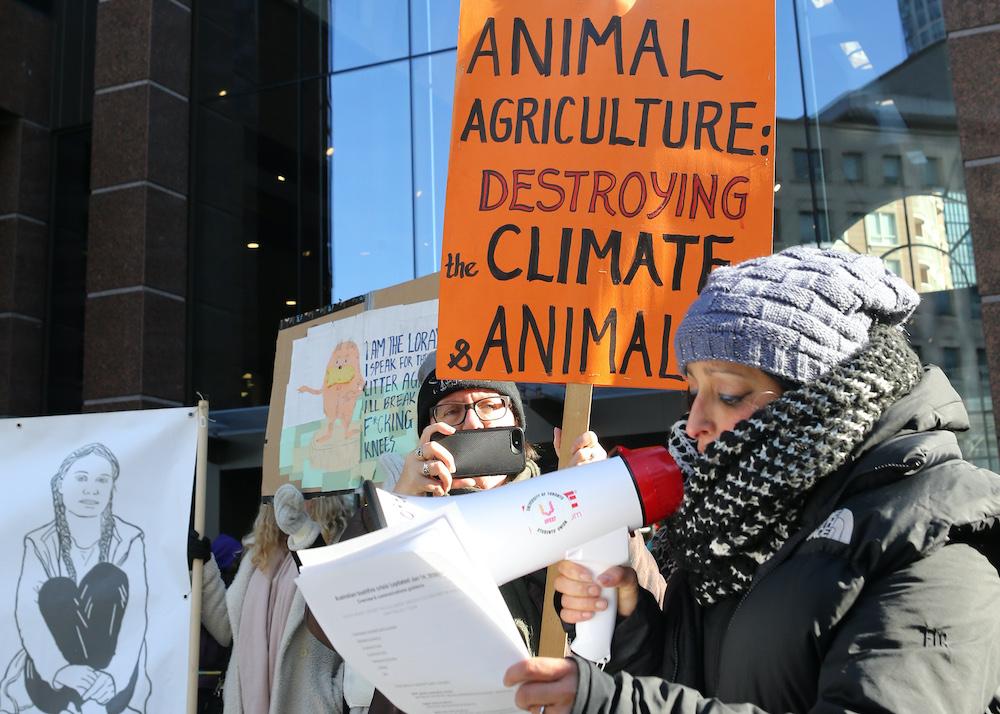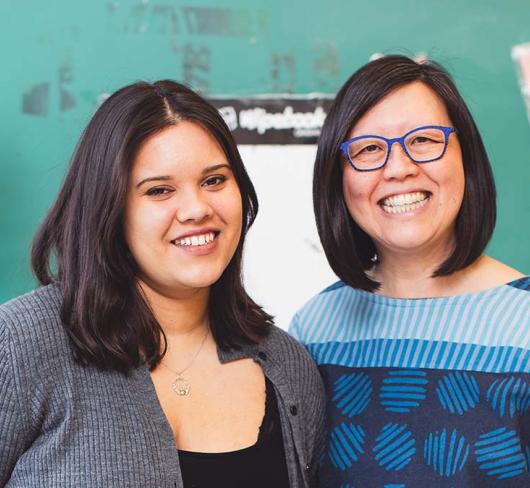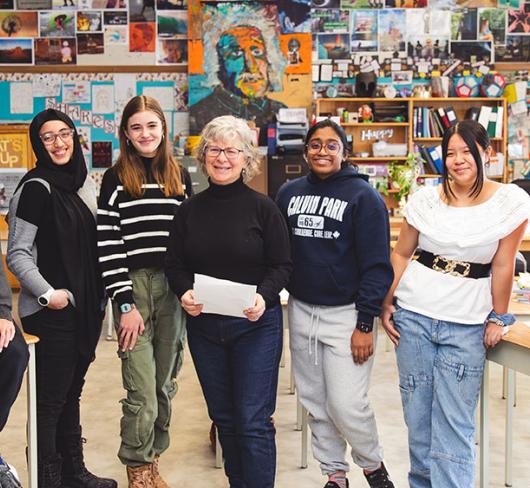
The Power and Promise of the Youth-Led Global Climate Movement
I was a middle school student in the late 80s when Earth Day was revived and young people started getting more active around environmental issues. Growing up along the St. Lawrence River in a polluted, industrial city, I jumped into environmental activism feet first. Although there were other youth interested in these issues and I was blessed with some adult supporters and mentors (including my neighbour and founder of the St. Lawrence River Institute for Environmental Sciences, Dr. Brian Hickey), it was sometimes a lonely path.
Since the Earth Summit in 1992, many people, young and old, around the world have worked on environmental issues and the climate crisis in myriad ways. Youth have long been at the centre of the movement. When I was part of the official Environmental Non-Governmental Organizations delegation to the 2005 United Nations Climate Conference in Montreal, the youth delegates were passionately and creatively pushing government officials to be bold and ambitious. This has been true of the many yearly COPS (climate conferences) around the world where governments adopt the Kyoto Protocol or the Paris targets for reducing greenhouse gas emissions. But little changes and emissions increase.
As a teacher and mom to a 17-year-old and 3-year-old, I have been in awe of the younger generation and their political sophistication. I think this generation’s strong sense of justice in part reflects the fact that teachers in Ontario and around the world are increasingly prioritizing environmental, social justice and Indigenous education. Whatever the reasons for their deep political understanding and strong sense of what is right, there has been fertile ground for rapid growth of a global student climate strike movement kicked off by Greta Thunberg in August of 2018.
I interviewed three young climate justice activists based in Ontario. Sophia Mathur was one of the first young people on the planet to join the Fridays for Future movement. She is a 12-year-old student in Sudbury who is part of a group of youth who are suing Premier Doug Ford over his inaction on climate change.
Alienor Rougeot coordinates the Toronto Fridays for Future protests. She is 20 years old and a third year economics and public policy student at the University of Toronto.
Cricket Guest is a 20-year-old Algonquin Anishnaabekwe Metis activist who grew up in a small town an hour outside Ottawa on unceded Algonquin territory. She is currently based in Toronto and works with Fridays for Future Toronto as the Indigenous outreach coordinator.
SOPHIA MATHUR
KIM FRY: Can you tell me about yourself and how you first got involved in climate activism?
Sophia Mathur: When my mom was pregnant with me she decided to join the climate justice movement because she wanted me to grow up with a liveable future. When I was seven and my mom went to lobby in Washington, my dad and I used to go to the zoo instead. I asked “Why can’t I go? It’s my future too” and I started lobbying with my mom. I developed a passion for this movement. In the summer of 2018, I saw a video of Greta Thunberg starting her strike for the climate and I just knew it was a thing I had to do.
KF: What do you think is behind the success of the youth climate strike movement and why do you think Greta Thunberg has resonated with so many people?
SM: I feel like the movement is successful because we are youth. The climate movement has always been strong, but the importance of youth is that it is our future. Our voices in this movement are really powerful. The movement started by Greta Thunberg really just empowered youth, including myself, and it turned into this massive movement with millions of kids all around the world and adults joining in.
The entire point of the Fridays for Future movement is that we are trying to get politicians to do something and rallying and striking is not the only way. People can go to lobby their politicians and talk to their local representatives to get them to take action on the climate crisis. They can work with their municipalities, like we did here in Sudbury, to declare a climate emergency. There is lots you can do through politics.
KF: You are part of a group of young people working with EcoJustice to sue the Ontario government. Can you tell me more about this action?
SM: I started working on this case secretly in November, 2018. I want to be a lawyer when I grow up. I was excited for legal action because I had heard about the case where youth were suing the federal government in the U.S. and I saw the impact it was having on the government and how it was showing the world what youth can do. We are suing Premier Doug Ford because he isn’t doing enough to protect our future and he is putting our future in danger. I think this is an awesome way to bring forth this problem. He has to do something because we are in a climate emergency and I am excited to continue this lawsuit.
KF: What is your biggest wish for this first year in a new decade? What would you like to see the government do? What change would you like to see in 2020?
SM: I would like to see politicians listening to climate experts, which means the Intergovernmental Panel on Climate Change, the Paris agreement, the 1.5 ° report about global warming, Noble Prize-winning economists and more. I want politicians to take science-based actions on the climate crisis because we are in a climate emergency. We need to listen to those experts and politicians need to cooperate and not make this a party issue. The house is on fire and we need to do something now.
ALIENOR ROUGEOT
KF: Can you tell me how you first got involved in climate activism?
Alienor Rougeot: It’s a bit of a long story but as a kid I grew up around a lot of nature in the south of France and I remember when I got on the internet around the age of 10, I started learning about wildlife. I was that kid at school asking my teachers to do everything on biodiversity. Then the refugee crisis hit in Syria and a lot of refugees were arriving on the shore an hour away from my house. I met people from groups like Amnesty International and I started doing activism to help and, eventually, after being in these circles, people started asking me if I had heard about climate change. It is an issue that engages both my passion for animal protection and refugee issues. That’s when I became deeply committed to the climate justice side of things. When I moved to Toronto, I wanted to do things around climate and I found some places in student unions and on campus. Then Doug Ford was elected and I knew that was it, we need to take to the streets because it was getting too big. That coincided with Greta Thunberg starting to strike. I was looking around for anyone who wanted to do that with me and that’s when I met some of the core people who first got active.
KF: How do you feel about the state of the world as we begin a new decade? How have Fridays for Future helped focus your energy?
AR: 2020 has been brutal so far and the Australian fires are symptomatic of what is waiting for us all. People. Animals. And then all the wars and the attacks are clearly part of a broken system. Obviously it is causing a lot of pain, but also a little bit of excitement because this is it; we are getting so close to a tipping point. People are revolting and organizing everywhere.
Kids’ voices are trusted because there’s no way we have an agenda. I think a lot of people didn’t expect the power that was coming from the youth-led environment movement. For some people, it was just like “oh, cute kids with signs” and then it blew up and now it’s this huge force. And Fridays for Future allowed a lot of activists to focus on one type of action instead of having marches and other things. It was just that one name that unified it all across the whole world.
KF: What do you think might be the role of teachers in addressing climate change both inside and outside the classroom?
AR: Teachers have such a huge job. There is so much potential. Part of it will be answering questions their students might start having and addressing the eco-anxiety part of things which might be really hard for teachers to handle. Trying to navigate kids who want to attend the strikes and can they? Having classes come to the strikes can be educational for the kids as well, because we have speakers. And teachers are such a trusted voice. I know my parents trust teachers so much. It’s similar to when doctors speak out about something. The voices of teachers can convince other adults.
KF: One aspect of the youth climate movement that has been so impressive is the understanding of how social justice and climate change are linked. How does this impact your approach to activism and how has it influenced your work and some of the demands Fridays for Future Toronto has put out?
AR: It is so huge. For me it went from the refugee rights movement to climate, so for me it is so inter-related. That aspect really started with our group when we talked about Indigenous sovereignty, and the notion that Indigenous peoples have been fighting for this land for so much longer than settlers. And for Indigenous communities it is not even really activism as we usually think of it but a way of life to protect the land. We have to recognize that we are not the first activists; we have a lot to learn from Indigenous peoples who are way more affected. When we start talking about climate justice, it means talking about marginalized communities, communities that have been disproportionately affected by cuts and austerity measures. These communities are also most affected by climate change. For our demands, we really thought that it can’t be just about minor tweaks to a system and plastic straws. It’s a whole system that has been harming a lot of people and violating our planet. We need to address that whole system.
KF: What is your biggest wish for 2020?
AR: So many, but the first is that any extraction project that Canada has planned sound ludicrous to people, in the same way that we now think of smoking cigarettes as ludicrous. I also really hope that we see governments apply a climate lens to budgets in the same way that some are applying a gender lens to budgets. I hope that more people stop saying they are inspired by youth and instead realize that being an activist involves fighting for what you care about so even if you are an oil and gas worker, you can be a climate activist. 2019 was the year of mass realization, so maybe 2020 can be the year that everybody feels the same empowerment to take action...a cultural shift.
CRICKET GUEST
KF: Tell me a little bit about yourself and what inspired your climate activism?
Cricket Guest: I first started getting into activism when I was 12 years old. It started when I found online forums about feminism that included feminists of all ages sharing their views. This time in my life was very pivotal for me because it launched my skepticism and I began to look at the world differently and challenge systems that I didn’t know were harming me. I went from being the kid that was too shy to raise my hand even if I knew the answer to being voted “most likely to start a debate” by the end of high school. And this is because I started actively challenging systems and the people in them (i.e., my peers, my teachers, my family). My activism started with feminism, which in all honesty was a very white-centred feminism (as I am a white-coded native and still benefit from white privilege). It wasn’t until I read Women, Race, and Class by Angela Davis that my world shifted again, and my activism became more intersectional. Later, when I was 16, I started learning about environmental issues, specifically how colonization and white supremacy within the agriculture industry has led to so much destruction of and pain for the land, animals and humans.
KF: Could you share what role you think teachers, schools and teacher unions have to play in the climate justice movement?
CG: Educating students on the real history of Canada is a good place to start. The formation of “Canada” is seeded in a harmful and toxic mentality towards the earth. The mentality is that we as humans have ownership over land. We don’t. We do not exist on this land, and the land does not exist for us. We exist with the land. We take care of her and she takes care of us. But before we can move forward with climate solutions we need to look at our past to educate and acknowledge that the system isn’t broken; this system we are living in was designed this way, framed by colonization, imperialism and greed. Without acknowledging the source of our wounds we will never completely heal. In terms of the climate strike movement, I want to see BIPOC voices being elevated to the same degree as Greta Thunberg.
KF: Where do you turn for inspiration, to stay grounded and hopeful?
CG: For inspiration and grounding I turn to Earth herself. I grew up in a very tiny town an hour outside of Ottawa where connection to the Earth was not only accessible but unavoidable. I moved to Toronto over a year ago, and the disconnect from the natural world has been the most prominent and jarring aspect of living here. Running from meeting to meeting and protesting in spaces on grey cement surrounded by large grey buildings can be extremely isolating and draining. It becomes easy to get lost in the politics and the statistics and the fear. But when I return to my home lands, I ensure I spend a lot of my time with our mother. When I walk in the woods I feel cradled by the earth, I can feel her spirit. It reminds me why I do this; it’s for her, she’s alive, and spending time with her reminds me she continues to heal us despite how much she’s hurting. And I will do the same for her. We will take care of each other like my people have been doing for generations.
Kim Fry is a member of the Elementary Teachers of Toronto.

